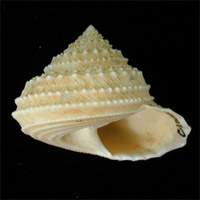|
< Previous family introduction |
|
 |
Family
Trochidae
Top Shells
|
|
The Trochidae is a large family with worldwide distribution, best known for the large tropical trochus shell, the nacreous interior of which is used for buttons. There is substantial variety in the family, with 13 subfamilies being recognised. Among these, shells vary in adult height from less than 5 mm to over 130 mm, and in shape from low auriform with a wide aperture, through the typical top shell shape, to long, slender forms. The unifying features are seen in the anatomy of the animals, in the nacreous internal shell layer and the circular, corneous operculum. The family is well represented in NSW, most species occurring here being endemic to Australia, with a few being restricted to the state. They occur in a wide variety of habitats; Austrocochlea porcata is the most abundant animal on many rocky shores, both exposed and sheltered. A variety of small trochids occur commonly under rocks and on algae in the low intertidal zone. Below low tide level Bankivia fasciata is abundant on soft bottoms where there is moderate wave action, often being washed up on beaches in the millions. Clanculus and Calliostoma species occur in deeper water, and Calliostoma glyptus is common on the continental slope. The range of diets of the trochids corresponds to the range in habitats. Hard substrate species graze on algae, algal spores, detritus or bacteria; some species live on and consume macroscopic algae. The Calliostomatinae, which occur subtidally, live in association with their food of sessile invertebrates; coelenterates, sponges and tunicates. The Umboniinae, which are infaunal soft-bottom inhabitants, are unusual in the family as they filter particulate matter from the water and bind it in mucous for consumption. Family Reference Hickman, C.S. & McLean, J.H. 1990. Systematic revision and suprageneric classification of Trochacean gastropods. Natural History Museum of Los Angeles County, Science Series 35:1-169. Identification Notes Trochids are characterised by a circular, corneous operculum and an internal nacreous shell layer. The most closely related family is the Turbinidae, in which most species have a calcareous operculum, except in the subfamily Angariinae, where the operculum is corneous as in the Trochidae. All the known NSW trochids are figured here, with the exception of the following widespread Indo-West Pacific species: Euchelus atratus (Gmelin, 1791). Indo-West Pacific to Evans Head, NSW; length to 23 mm. |